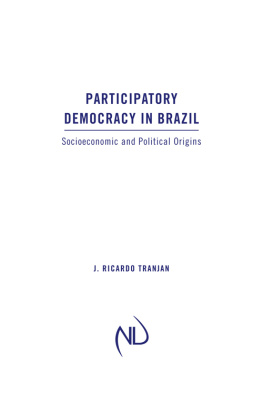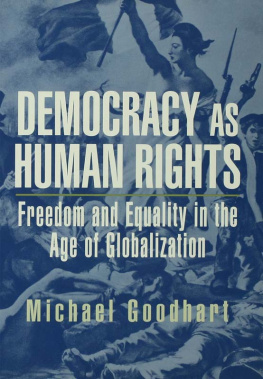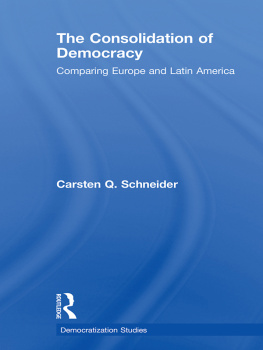DECISION COSTS AND DEMOCRACY
For my parents
Decision Costs and Democracy
Trade-offs in institutional design
ROBERT E. BOHRER II
Gettysburg College, USA
First published 2001 by Ashgate Publishing
Reissued 2018 by Routledge
2 Park Square, Milton Park, Abingdon, Oxon OX14 4RN
711 Third Avenue, New York, NY 10017, USA
Routledge is an imprint of the Taylor & Francis Group, an informa business
Copyright Robert E. Bohrer II 2001
All rights reserved. No part of this book may be reprinted or reproduced or utilised in any form or by any electronic, mechanical, or other means, now known or hereafter invented, including photocopying and recording, or in any information storage or retrieval system, without permission in writing from the publishers.
Notice:
Product or corporate names may be trademarks or registered trademarks, and are used only for identification and explanation without intent to infringe.
Publishers Note
The publisher has gone to great lengths to ensure the quality of this reprint but points out that some imperfections in the original copies may be apparent.
Disclaimer
The publisher has made every effort to trace copyright holders and welcomes correspondence from those they have been unable to contact.
A Library of Congress record exists under LC control number: 2001089097
ISBN 13: 978-1-138-73684-9 (hbk)
ISBN 13: 978-1-315-18571-2 (ebk)
Contents
The seeds of this project were planted over a decade ago, while I was working as a correctional officer in Nebraska. During my (thankfully) brief career in this capacity, I had the opportunity to work in two markedly different facilities. One facility was reminiscent of B-grade prison movies: a dark, damp, depressing cellblock, complete with iron bars on every conceivable opening. The other facility was still quite secure, but doors replaced the bars, windows replaced the darkness and the cellblock replaced by a housing unit.
These contrasting physical institutions produced marked differences in inmate behavior. Tension, aggression and animosity characterized the former setting. Though these attributes were not absent in the latter institution, the general behavior of inmates was less hostile and more manageable. This experience represented to me in a very non-academic way that institutions do indeed matter.
While the seed was planted at that time, the germination of the final product has taken many years and has benefited from the efforts of many individuals. John Robertson helped shape my personal experience into an academic effort through several years of constructive criticism, advice and encouragement. He supervised the transformation of this idea from an interesting anecdote to a theoretical framework in my dissertation and provided the impetus to just keep going with the idea once the dissertation was complete. Alex Pacek, Guy Whitten, Harland Prechel, Jim Anderson and Alex Tan all provided useful comments and difficult questions on drafts of this work while Glen Krutz provided the nudge I needed to work on revising my dissertation into a book. Stephen Borrelli and Terry Royed generously supplied their data for my use, a courtesy for which I am very grateful. The people at Ashgate have been wonderfully supportive and helpful in getting this book into shape and dealing with the devilishness of providing camera-ready copy.
In addition, the Department of Political Science at Gettysburg College has provided both financial support and the encouragement of my colleagues. Nazir Tyrewala provided valuable data collection and Jessi Saracino proved to be an invaluable research assistant, ably carrying out both arduous and last-minute tasks necessary for the completion of this work.
Finally, my family has provided me with an immense level of support and encouragement for several years. My wife, Sandy, has listened to countless renditions concerning the importance of democratic institutions and their effects, and my daughter, Jenna, has been understanding of my time in front of the computer. My greatest debt is to my parents, Betty and the late Bob Bohrer, to whom this work is dedicated. Because of their hard work, encouragement and sacrifice I was able to have opportunities they could only dream of.
Democracy is the worst system devised by the wit of man, except for all the others
Winston Churchill
Introduction
In Churchills time, democracies were relatively scarce. As Britain stood alone against the Nazi onslaught, Europe was under the thumb of totalitarian rule and one of the handful of remaining democracies, the United States, clung to neutrality. In the aftermath of World War II the southern part of Europe remained in flux and under authoritarianism. In the east, communist takeovers were ending any chance of self-determination in that region. Since Churchills time, things have changed dramatically with transitions to democracy occurring on every continent. In places where democracy would have seemed unthinkable fifty years ago countries such as Spain, Poland, Malawi, and Mongolia democratic institutions are operating.
When discussing different forms of government, one tends to think in general terms such as democratic, authoritarian, or totalitarian systems. While these are certainly important distinctions, within each of these categories there are many varieties. For example, the relatively popular and benign kingdom of Jordan is an authoritarian system but so was the repressive rule of Idi Amin in Uganda. By terming both of these systems as simply authoritarian we are unable to distinguish some very meaningful differences. In short, these categories are so broad as to provide only very general distinctions. When comparing democracies to other types of government, Churchill is tapping into a very important distinction, but among democratic systems there are profound differences. For example, the Italian system is well known for its instability and average government duration of around ten months in the post-war era. In addition, the fact that France has experienced revolution, several emperors and five republics since the passage of the American constitution shows a volatile past. By delving into variations within the category of democracy, we should be able to identify and classify these differences. Moreover, these variations are likely not all cosmetic they should matter.
This book addresses the variations in democratic institutional design and seeks to determine not only if these differences matter, but also to explain how they matter. Using data from established, economically well-off systems we see that not only are there a multitude of ways to construct a democracy but also that how a democracy is constructed influences the outcomes produced by that system. In other words, institutional differences create distinct incentives for behavior that in turn influence the type of outcome produced. An example from the experience of the United States helps clarify this point.
Institutions and Outcomes: An American Example
As the worlds oldest continuous democracy, the United States is viewed as a model of stability. Even casual observers are aware of the distinction between the American President and Congress, and the more interested observer will generally point out the role of the Supreme Court and the federal nature of the system. Similarly, one could point to the presence of merely twenty-nine constitutional amendments as evidence of the stability of American governmental institutions. However, as more intimate observers will note, the current federal arrangements of the government of the United States at one time looked dramatically different. In an effort to avoid the concentration of power found in monarchies of the day and to ensure the power of states, the original American system was confederal in nature with a very weak national government and an even weaker executive. Why did this change occur?











